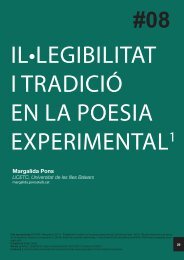03 - 452ºF
03 - 452ºF
03 - 452ºF
Create successful ePaper yourself
Turn your PDF publications into a flip-book with our unique Google optimized e-Paper software.
equires their charity in order to survive. Sharpe also states that the<br />
accused does not attend church regularly and is often heard scolding<br />
or cursing her neighbors (1996: 63). The woman described here is<br />
one living outside of normative gender expectations, and, as such,<br />
is a threat.<br />
There is perhaps no greater threat in the town of Springfield as<br />
«The Crazy Cat Lady». With a given age of 78 and having lived as a<br />
single woman for her entire adult life, it is interesting that the series<br />
depicts her as not only a «cat lady,» but as a «crazy» one. She is<br />
discussed as being mentally ill in numerous episodes; however, the<br />
audience learns in «Springfield Up» that this is due to stress. Yet,<br />
this stress is caused from having entered into the male-dominated<br />
public spheres of law and medicine. By the age of thirty-two she had<br />
bonded with her first cat, in a downward spiral of mental illness, to<br />
never find a male companion. Most of what she says is unintelligible,<br />
and, yet, the few words that are clear are always curses 5 . As Mary E.<br />
Wiesner explains, women living without male figures—whether they<br />
be husbands or fathers—were «more suspect in the eyes of their<br />
neighbors» (2000: 268). While Wiesner refers here to the women<br />
accused of witchcraft during the Early Modern era, it is interesting<br />
that The Simpsons, a reflection of modern views regarding gender<br />
roles, chooses to portray this woman as «crazy»—crazy for being<br />
unattached to a man and attempting to enter into male-dominated<br />
fields of work. And while the series’ focus on gender expectations<br />
will be discussed more in-depth in relation to Patty and Selma, the<br />
show often aligns single, elderly women with witchcraft in the same<br />
manner described by Wiesner.<br />
2. «Easy bake coven» from «Treehouse of horror VIII»<br />
This segment of the eighth Halloween episode serves to explain the<br />
beginnings of Halloween traditions. While the episode’s faithfulness<br />
to the origins of the holiday is slim at best, it does prove very faithful<br />
to the context of the witch trials of the 1600’s, especially in the<br />
American colonies. The vignette parodies the Salem witch trials;<br />
however, the motivations for the accusations and the construction<br />
of the witches themselves overlap with their Early Modern English<br />
counterparts. «Easy Bake Coven» (1997) takes place in the town<br />
of «Spynge-Fielde» in 1649 A.D. It begins with three women tied<br />
to stakes, surrounded by townspeople holding torches. Those<br />
being condemned as witches, referred to as «hags», represent the<br />
various types of women accused in the Early Modern period. Luann<br />
Van Houten, Milhouse’s mother, is a character who in the series<br />
has recently left her husband. Mrs. Hoover, Lisa’s second grade<br />
teacher, is viewed as a spinster, although being far from elderly.<br />
NOTES<br />
5 | The age of «The Crazy Cat<br />
Lady» is in dispute, though.<br />
While official sources put out by<br />
The Simpsons’ creators place<br />
her age as 78, «Springfield<br />
Up» indicates that she went<br />
to high school with Homer<br />
Simpson. The notion of her<br />
craziness is also controversial,<br />
as the «medicine» she takes is<br />
revealed to be Reese’s Pieces<br />
in «Homer and Ned’s Hail Mary<br />
Pass» (2005).<br />
The Simpsons, Gender Roles, and Witchcraft: The Witch in Modern Popular Culture - Sarah Antinora<br />
<strong>452ºF</strong>. #<strong>03</strong> (2010) 115-131.<br />
120










